T TYPE
Antecedents
The history of the MG T Type is well documented. Many books have been written on MG’s and T Types in particular. However, because of the passage of time these books are now becoming difficult to find or expensive to buy accordingly an abbreviated history of the type by Aubrey Paverd is offered below, both for members of the T Register and for the casual browsers of this web site. Books used in compiling this document are listed both as recognition of the source of the information and for those interested in delving further into the history of these iconic sports cars.
The history of the T type midget really began with the introduction of the M type midget at the London Motor Show in 1928. The M type was the first MG midget and also the first car to be produced by MG in its own right; the MG Car Company was registered only a few weeks before the show. It was an immediate success and was followed by a succession of midgets each one a development of its predecessor. The M type used an 847cc overhead camshaft engine rated at 20bhp, which was identical to the Morris Minor engine. Over the next eight years the engine and chassis of the M type were modified and improved leading to the development of the C and D types in 1931, the J type in 1932 and ultimately the P type in 1934. The PB, the last of the midgets to be equipped with the overhead camshaft engine, was a much improved car and owed little to its Morris origins. It had bigger brakes, a 46 bhp motor, better weather protection and was larger and more comfortable than the original M type. However, due to management changes within the Nuffield organisation and the unavailability of the Wolseley derived overhead camshaft engine the P type was phased out in early 1936 to be replaced by the TA; a very different car in every way except appearance.
Robin Page’s M Type ready to do battle with the Austin 7’s
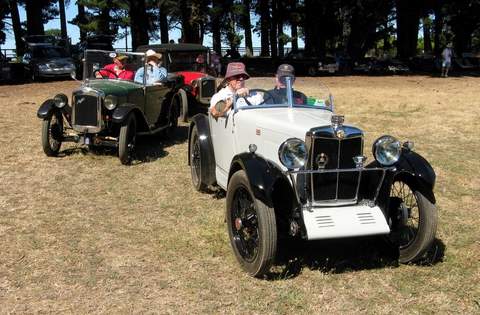
The TA and TB
The 1936 TA midget had a 1292 cc pushrod engine rated at 50 bhp, much larger than the 939 cc 46 bhp of the PB. It was 2 cwt heavier, the wheelbase was 7” longer, it had hydraulic brakes and from August 1936 was equipped with synchromesh on third and fourth gear; a first for the MG midget line. It was also roomier and more comfortable. The introduction of the TA marked the transition of the MG from a car that appealed essentially only to the enthusiast to one that could be appreciated by all members of the motoring fraternity.
The TA midget MPJG overhead valve engine of 1292 cc was derived from the Morris MPJM engine, which in turn was derived from the 1932 Series 2 side valve Morris Ten/Four engine. It had a bore of 63.5mm and stroke of 102mm. Because of the long bore and therefore high piston speeds and the fact that the crankshaft was not counterbalanced the TA engine was considered unsuited for further development. Consequently when the TB was introduced in 1939 it was similar in nearly all aspects to the TA except the engine.
The TB, 1250cc, XPAG engine, which would power T types until production ceased in 1955, was a development of the Morris 1140cc XPJM engine, which in turn was again another development of the Morris Ten/Four side valve engine. Morris recognising that redevelopment of the MPJM engine was necessary, reduced the stroke of the engine to 90mm, counterbalanced the crankshaft and redesigned the head producing a rugged little engine of 1140cc which gave 37 bhp at 4,600 rpm. MG saw the engine had potential and increased the bore to 66.5mm from 63.5mm for a capacity of 1,250cc, implemented a number of other changes, including improving the breathing and valve timing to produce an engine that gave 54 bhp at 5,200 rpm. Only 379 TB’s were produced prior to the onset of WWII, when the facilities at Abingdon were given over to war production.
The TC
At the end of the war MG, like so many other British car manufacturers, simply dusted off the old plans and started production of cars that were essentially out of date. The TC was a TB with a 4” wider body, shackled springs instead of trunnion mounted springs and a single 12 volt battery mounted on the engine bulkhead instead of two 6 volt batteries behind the seats. Production of the TC began in September 1945 and continued until November 1949.
The TC was a pre-war car, built post-war. Abingdon did not expect great things of it, but it was a sellers market after the war and they underestimated the acceptance of the car overseas.
The popularity of the MG TC was surprising when compared to most other post-war cars, particularly the American ones, which had heaters, large capacity, powerful engines and which were comfortable and relatively quiet. The TC made no concessions to comfort and had a small, noisy engine. However, despite its modest performance it could be flung about with abandon and with its four speed gearbox and freely revving engine was a joy to drive.
TC ownership ranged all the way from the man in the street to famous actors and budding race car drivers. Because it was easily modified it became the car of choice for the ‘boy racer’ fraternity. A total of 10,000 units were produced; more than the entire production of 8,451 midgets between 1928 and 1936 when production of the P type ceased. Phil Hill, the 1961 Formula I champion, raced a modified TC at the start of his career in 1951, whereas at the other extreme, Prince Phillip of Greece, now the Duke of Edinburgh, courted his wife to be in a shiny new black TC in the late forties. There is no doubt that the TC introduced MG to the world and in the USA it came to epitomise the English sports car.
Two Clipper Blue TCs at a Cars of the World display, 2008
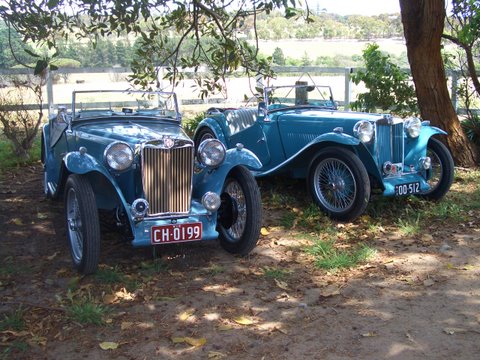
The TD
By 1949 the TC, with its TA pre-war, cart springs and flexible chassis, was well and truly dated. In 1947 MG had brought a new saloon into production, the YA. It had a box chassis and independent coil and wishbone front suspension, designed by Alec Issigonis. The Y type was well accepted and the engineers at MG, recognising that the suspension represented an important advance, simply shortened the Y type chassis and placed a TC body on it. This was the TD prototype.
Production of the MG TD began in November of 1949. It was similar in appearance to the TC, but there were a number of important differences in addition to the more rigid box chassis and independent front suspension. The TD had a wider stance than the TC and to satisfy the North American market came in left hand drive and grew front and rear bumpers. The 19” centre laced TC wire wheels were replaced by 15” disc wheels and the turning circle was reduced from 37 ft to 31.5 ft. The engine remained the same, but the braking system was updated and the spiral drive differential was replaced by a more modern hypoid drive version.
The car received a poor reception from MG aficionados, but its improved cornering ability and more comfortable ride soon overcame objections and the TD became the best selling car of the T types. In all 29,664 cars were produced with 20,007 exported to the USA. The TD continued in production until late 1953 with little modification. As of 1951 a TD Mark II model, designed for competition, was offered in addition to the standard TD. The engine had larger valves, an increased compression ratio and larger 1½ “ SU carburettors instead of the standard 1¼ “ . Other changes included a higher final drive ratio, friction shock absorbers to lessen body roll and dual fuel pumps. Total production of the Mark II model amounted to 1710 units, of which 1593 were exported to the USA.
Doug Hastie’s TD at work
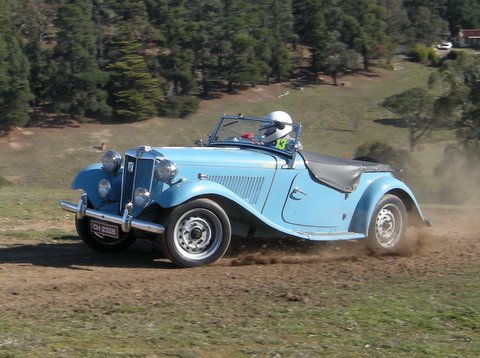
The TF
Towards the end of 1952, management at Abingdon, recognising that the ‘square rigger’ MG had had its day, submitted a new streamlined car for to BMC management for approval as the prototype for MGs next car. The car was basically a tuned TD and was based on a streamlined race car built for George Phillips by MG. It was a known as the EX 175 prototype.
Unfortunately for MG, earlier in 1952 Donald Healey had concluded an agreement with BMC through Leonard Lord for production of a new sports car based on the Austin A90. Leonard Lord, back in charge for the second time as the new MD of the merged BMC, with the short-sightedness that was to become endemic at BMC and later BL, saw no reason to produce two new sport cars and vetoed the project. This despite the fact that the Austin-Healey was built for an entirely different market and cost almost twice as much at £ 1,063 as the proposed EX 175.
Sales of the TD declined drastically in 1953 falling to almost half the previous years level. BMC management observing the drastic decline ultimately agreed that something should be done, but would only approve a facelift of the TD. This was a classic example of too little too late and when the TF appeared at the 1953 Motor Show it was universally panned by the motoring press at home and abroad.
The fact that Triumph had unveiled their new, streamlined TR 2 did not help either. The TR 2 was a 2 litre, roadster with a genuine top speed of over 100 mph and, despite its rather suspect handling, was well received by the motoring public, particularly since it only cost £ 5 more than a TF.
The TF used the Mark II TD engine, had bucket seats instead of the one piece seat of the TD and TC, and had headlights integral with the body of the car. It also had modified wheel hubs so that wire wheels could be offered as an option. Top speed was around 74 mph, no better than the pre-war TA of 1939. A total of 6,200 units were produced between October 1953, when the car was launched at the motor show and July 1954 when the TF 1500 was introduced.
The only difference between the TF and the TF 1500 was the capacity of the engine, which was a XPAG 1250 bored out to 1466 cc; renamed the XPEG. It developed 63 bhp as opposed to the 57 bhp of the TF 1250 and enabled the TF to reach a top speed of 88 mph. A total of 3,400 units were produced until the introduction of the MGA in 1955.
Despite its poor reception by the motoring public the TF is today regarded as perhaps the most attractive of all the MG Midgets. It heralded the end of the production of the square rigger MG’s and the XPAG series of motors, which in one form or another had been in production since 1936.
The successor to the TF 1500, the MGA, was introduced in the autumn of 1955. It was streamlined, had a new chassis and motor and was received with acclamation by the motoring public. In the first year of production BMC sold more than 13,000 MGA’s; more than the total production run of the TC. The T Types were gone but, even today some 54 years later, are not forgotten and continue to be regarded as the iconic British sports car.
Mark Webber in a TF at Albert Park F1 GP 2008
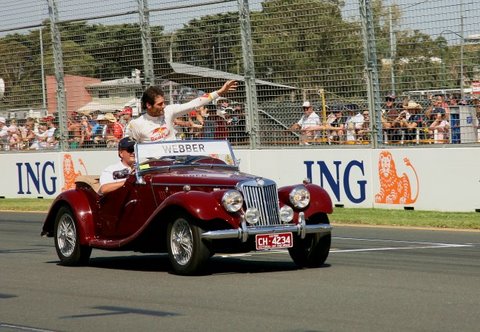
Y TYPE
A short history of the MG 1 1/4 litre Y Series
by David Pelham and David Lawrence
In the years immediately before the Second World War, MG had sought to supplement their popular range of ‘Midget’ sports cars with three saloons of various sizes and engine capacities. These were the “S”, “V” and “W” models. The MG factory at Abingdon on Thames had grown by developing what were in essence Morris based products and they were always to be closely associated with what was to become the Nuffield Organisation (Morris, Wolseley and later Riley). The “WA” had an engine capacity of 2,561 cc, the “SA” 2,288 cc and the smallest of the group, the “VA”, had an engine of 1,548 cc. The next development to the range was to include one more saloon, of smaller engine capacity than the “VA”, and for a component-base the Cowley design office turned to Morris’s Ten-Four Series M saloon, which was introduced during 1938, and the smaller Eight Series E which was launched at the Earls Court Motor show the same year.
The prototype “Y” Type was constructed in 1939 with an intended launch at the Earls Court Motor show, the following year. However, as a result of the hostilities the public had to wait a further eight years before production commenced. All prototypes originating from the MG Factory at Abingdon were allocated numbers prefixed by the letters EX; this practice continued until the mid-fifties. Although the prototype of the MG “Y” Type was primarily a Morris concept from Cowley, much of the ‘fleshing out’ was completed at Abingdon. As a result it was allocated the prototype number EX.166. The car would feature an independent front suspension layout designed by Alec Issigonis (famous for designing the Mini in 1959) and Jack Daniels (an MG Draughtsman). Independent front suspension was very much the latest technology at the time and the “Y” Type became the first Nuffield product and one of the first British production cars with this feature.
Gerald Palmer was responsible for body styling and, in essence he took a Morris Eight Series E four-door bodyshell in pressed steel, added a swept tail and rear wings, and also a front-end MG identity in the shape of their well-known upright grille. The MG 1 1/4 Litre Saloon would retain the traditional feature of separately mounted headlights at a time when Morris was integrating headlamps into the front wing and it was also to have a separate chassis under this pressed-steel bodywork, even though the trend in the industry was towards ‘unitary construction’. The separate chassis facilitated the ‘Jackall System’, which consisted of four hydraulically activated rams that were clamped to the chassis, two at the front and two at the rear. The Jacks were connected to a Jackall Pump on the bulkhead that enabled the front, the back, or the entire car to be raised to facilitate a wheel change.
The power unit was a single carburettor version of the 1,250 cc engine used in the latest “TB” Midget. This engine, the XPAG, went on to power both the “TC” & “TD” Midgets. The MG Y Type developed 46 b.h.p. at 4,800rpm, with 58.5lb ft of torque at 2,400 rpm. With the exception of only the Rover Ten, which managed 2 additional b.h.p., the “Y” Type had more power than other British saloons of similar size. Indeed at the time many manufacturers were still producing side valve engines.
The MG “Y” Type had an extremely high standard of interior furnishing and finish, in accordance with the best British Traditions. The facing surfaces of all seats were leather, as were the door pockets. The rear of the passenger seats were made from Rexine, a form of leathercloth, which matched the leather fronts. Considerable use of wood was made in the internal trim of the “Y” Type, where it was a major feature of the inside finish. Unfortunately the “Y” Tourer did not benefit from ‘displayed’ woodwork but had the same standard of seat trim.
When the car was launched the MG Sales Literature stated “A brilliant new Member of the famous MG breed. This new One and a Quarter Litre car perpetuates the outstanding characteristics of its successful predecessors – virile acceleration, remarkable ‘road manner,’ instant response to controls, and superb braking. A ‘lively’ car, the new One and a Quarter Litre provides higher standards of performance.” The price of the car was £525.0.0 ex works plus purchase tax of £146.11.8d.
In 1948 several (currently believed to be 9) “Y” Types (consisting of chassis, engines and some body parts) were imported into Switzerland and given cabriolet bodywork by various coachbuilders, such as J. H. Keller and Reinbolt and Christé. The idea of the open four-seat tourer had been popular before the war and in theory there was still a market. As a result a “TC” specification of the XPAG engine was married to a pressed-steel open body with fully folding hood and coach built doors. The MG “Y/T” was launched at the Motor Show in 1948. However, it was available for export only but would be available in both Right and Left hand drive models. Only 915 of these cars were produced when production ceased in 1950 – it was not the success that MG had hoped for, and indeed other British manufacturers were also having problems selling open tourer versions of their saloons.
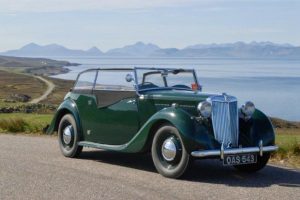
In 1952 MG Car Company updated the “Y” Type and an improved model was launched, known as the “YB”. The “YB” had a completely new Lockheed braking system and a much more modern type of back axle. The road holding was also improved by the introduction of 15 inch wheels; the “Y” and the “Y/T” had 16 inch wheels. The “YB” also had an anti-roll bar fitted to the front of the car and better dampers were fitted.
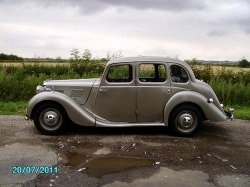
When production ceased in 1953 8,336 “Y” Types had been produced, the breakdown being: 6,151 “YA”s (including 9 cars supplied to Swiss and Italian custom coachbuilders for special bodies), 1,301 “YB”s and 915 “Y” Tourers.
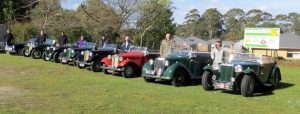
A recent gathering of T’s and Y
Bibliography
MG by F. Wilson McComb
The MG File, Dymock Motoring Books
Maintaining the Breed by John Thornley
MG T Series in Detail by Paddy Wilmer
MG T Series the complete story by Graham Robson
Engines for MG’s by Neil Cairns
Y type – The International MG Y Type Register website. David Pelham and David Lawrence
